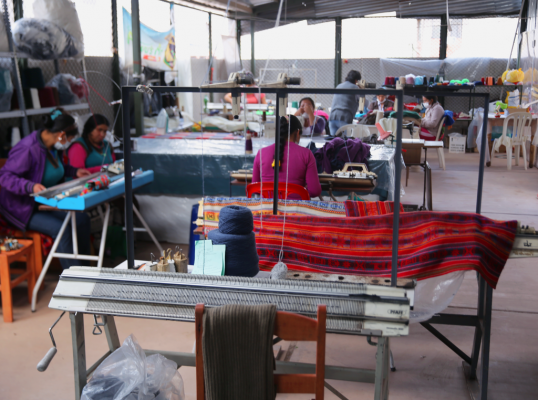By Dennis Shaughnessy
The topic of prison labor has long been a controversial one, both in the US and around the world. In the US, prisoners who work under structured programs typically receive less than $1.00 per hour for their labor as part of the Federal Prison Industries program. The market for US prisoner-made products, most of which are sold to government buyers, exceeds $500 million annually. Many believe prison labor is a modern form of slavery, while others suggest that the work provides an opportunity for imprisoned people to provide for their families while learning new marketable skills to be used upon their release.
Thousands of miles to the south, in Cusco, Peru, poor and incarcerated women in the local prison can earn $180 to $329 per month sewing indigenous clothing like alpaca wool shirts and sweaters. These women volunteer to work five hour shifts five days a week, sewing and stitching high-end clothing items for export (a baby alpaca T shirt sells for $190). A social enterprise founded in Denmark called Carcel began its program two years ago, and now more than 50% of the 5,000 incarcerated women in the country are employed producing leather goods, clothing and textiles for export.

Another program called Project Pieta is working with prisoners, male and female, to create work opportunities for prisoners in Lima. A social enterprise organization called NESsT in Peru that works with social entrepreneurs to create dignified jobs for poor and low income people is now the home of this small but impactful project.
Most of the women in Peruvian prisons, like the one in Cusco where Carcel began its work, are serving long sentences for drug and other crimes of “poverty” like theft and prostitution. About 85% of these women have left behind young children, most of whom live in poverty.
The policy debate is whether employing imprisoned women from poor communities to make luxury goods is exploitation that diminishes the lives of women, or instead a social innovation that enhances their lives both while in prison and after their release. Carcel has recently been subjected to a great deal of online criticism for using “slave labor” for profit under the banner of “sustainable business models”. Yet their products, sold as a fashion brand with a “social purpose,” are often sold-out and back-ordered due to their popularity.
The answer to the exploitation vs. opportunity question appears not surprisingly in the design of the program, the conditions of the prison workplace and the destination of the profit generated by these products.
Decent and dignified work conditions, fair wages (women working for Carcel earn as much as an elementary school teacher in Peru), meaningful education and training opportunities, financial literacy and money management tools and counseling in areas such as self-esteem and personal empowerment are all important elements of a well designed and managed program. The opportunity not only to sew or weave these fashion products but also to design them also enhances the experience for women while addressing the cultural appropriation issues that often arise from the sale of indigenous designs by large retailers.
From our perspective, Carcel appears to have built a high impact social enterprise by creating meaningful opportunities for dignified and living wage work for poor incarcerated women in Peru. While we haven’t seen any financial information, so long as the profits from the sale of products made (and designed) by these women are shared and reinvested in the mission consistent with the “social business” model pioneered by Dr. Muhammad Yunus, then we see opportunity creation rather than exploitation at the center of the enterprise.
The next hurdles in Carcel’s development will come with a new prisoner program in Thailand, the country that has the most women prisoners in the world, and regulatory clearance to sell their products in the US.
This article was informed by a New York Times piece written by Elizabeth Paton and Andrea Zarate and published on February 24, 2019.


